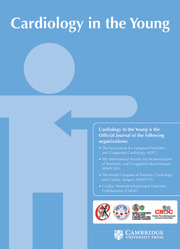No CrossRef data available.
Article contents
Screening For Critical Congenital Heart Disease Using Pulse-Oximetry, The First Egyptian Multicentre Study
Published online by Cambridge University Press: 17 February 2025
Abstract
Congenital heart Disease (CHD) is a significant cause of morbidity and mortality. Pulse-oximetry is a good non-invasive simple tool for critical CHD screening. Implications of this tool may be possible in certain areas and non-practical in others. We aim to report on the preliminary results of a recent ongoing protocol concerning the use of pulse-oximetry in detecting critical CHD in newborn in Egypt.
All neonates born in or transferred to 10 university hospitals during the period between February and November 2023 and fulfilled the criteria of inclusion were screened for critical CHD by pulse-oximetry using Granelli protocol in the first 24–72 hours after birth.
During a 10-month pilot period, a total of 2392 neonates were screened. A total of 549 neonates (23%) tested positive (failed) screening. Among the positive cases, 213 neonates (42%) died during their hospital stay, while the remaining were discharged or scheduled for intervention. The positive cases underwent echocardiography that revealed CHD in the majority of cases (80.3%). Only 40 cases of those cases had cardiac defects that are classified as critical CHD with a prevalence of 16.7 per 1000 live births, while the rest of the cases have either simple (non-critical CHD) or persistent pulmonary hypertension. About 19.7% of positive cases have completely free echocardiograms without cardiac defects.
The prevalence of critical CHD in Egypt is higher than the mean worldwide prevalence. The introduction of pulse-oximetry as a mass screening tool for critical CHD is possible and effective in low-income countries.
- Type
- Original Article
- Information
- Copyright
- © The Author(s), 2025. Published by Cambridge University Press



